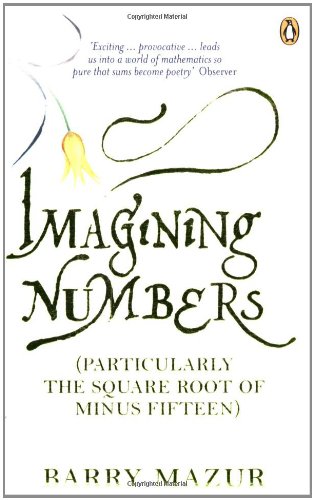Imagining Numbers : (Particularly the Square Root of Minus Fifteen) - Softcover

"synopsis" may belong to another edition of this title.
1, 2, 3, . . . The "counting numbers" are part of us. We know them forward and backward. Babies as young as five months old, psychologists claim, are sensitive to the difference between 1 + 1 and 2 - 1. We sing numbers, counting up the days of Christmas and counting down to the poignant monotheism of "One is one and all alone and evermore shall be so."
Our ancestors have added to this repertoire and reckoned with zero and the negative numbers, which were sometimes referred to as fictions (fictae) before they gained familiarity.
All these together constitute what we call the whole numbers, . . . , -2, -1, 0, +1, +2, . . .
More formally, they are called integers, from the Latin adjective meaning "whole, untouched, unharmed."
"Whole," "untouched"; their very name hints that integers can be touched, or fractionated. Indeed they can be, and when they are, we get the larger array of numbers that are fractions, ratios of whole numbers.
Fractions, as their notation vividly displays, also stand for proportions (think of 1/2 = 2/4 as "one is to two as two is to four and for actions (think of 1/2 as "halving," ready to cut in half anything that follows it). To bring fractions into line, we express them as decimals (1/2 = 0.5000000 . . . ). The modem world gives us much experience with decimals to a high degree of accuracy -- to "many decimal places"; mathematics, as always, goes all the way, happy to deal with numbers with complete accuracy -- to infinitely many decimal places. Numbers represented by infinitely many decimal places, whether they are fractions or not, are called real numbers.
But the telltale adjective real suggests two things: that these numbers are somehow real to us and that, in contrast, there are unreal numbers in the offing. These are the imaginary numbers.
The imaginary numbers are well named, for there is some imaginative work to do to make them as much a part of us as the real numbers we use all the time to measure for bookshelves.
This book began as a letter to my friend Michel Chaouli. The two of us had been musing about whether or not one could "feel" the workings of the imagination in its various labors. Michel had also mentioned that he wanted to "imagine imaginary numbers." That very (rainy) evening, I tried to work up an explanation of the idea of these numbers, still in the mood of our conversation.
The text of my letter was the welcome excuse for continued conversation with a number of friends, many of whom were humanists interested in understanding what it means to imagine the square root of negative numbers. The successive revisions and expansions of my letter were shaped by their questions, comments, critiques, and insights. This book, then, is written for people who have no training in mathematics and who may not have actively thought about mathematics since high school, or even during it, but who may wish to experience an act of mathematical imagining and to consider how such an experience compares with the imaginative work involved in reading and understanding a phrase in a poem. Of course, poetry and mathematics are far apart. All the more glorious, then, for people at home in the imaginative life of poetry to use their insight and sensibility to witness the imagination at work in mathematics.
Although no particular mathematical knowledge is necessary, pencil and paper are good to have at hand, to make a few calculations (multiplying small numbers, mostly). The operation of multiplication itself is something we will be looking at. There are three standard ways of denoting the act of multiplication: by a cross ×, by a centered dot ·, or, when there is no ambiguity, by simple juxtaposition of the objects to be multiplied. Which notation we use reflects where we wish to direct our attention: the equation
2 x 3 = 6
emphasizes the act of multiplying 2 times 3, whereas
2 · 3 = 6
focuses on the result, 6, of that operation. Nevertheless, despite this difference in nuance, both equations, 2 x 3 = 6 and 2 · 3 = 6, are saying the same thing. When we deal with an unknown quantity X, here are three equivalent ways of denoting 5 times that unknown quantity:
5 × X = 5·X= 5X.
Again, we write 5 × X if we want to emphasize the act of multiplying and 5·X or 5X if we want to emphasize the result; and that last variant notation, juxtaposition, is used for visual conciseness.
Copyright © 2003 Barry Mazur
"About this title" may belong to another edition of this title.
- PublisherPenguin Books Ltd
- Publication date2004
- ISBN 10 0141008873
- ISBN 13 9780141008875
- BindingPaperback
- Rating
Buy New
Learn more about this copy
Shipping:
US$ 4.13
Within U.S.A.
Top Search Results from the AbeBooks Marketplace
IMAGINING NUMBERS : (PARTICULARL
Book Description Condition: New. New. In shrink wrap. Looks like an interesting title! 0.48. Seller Inventory # Q-0141008873

